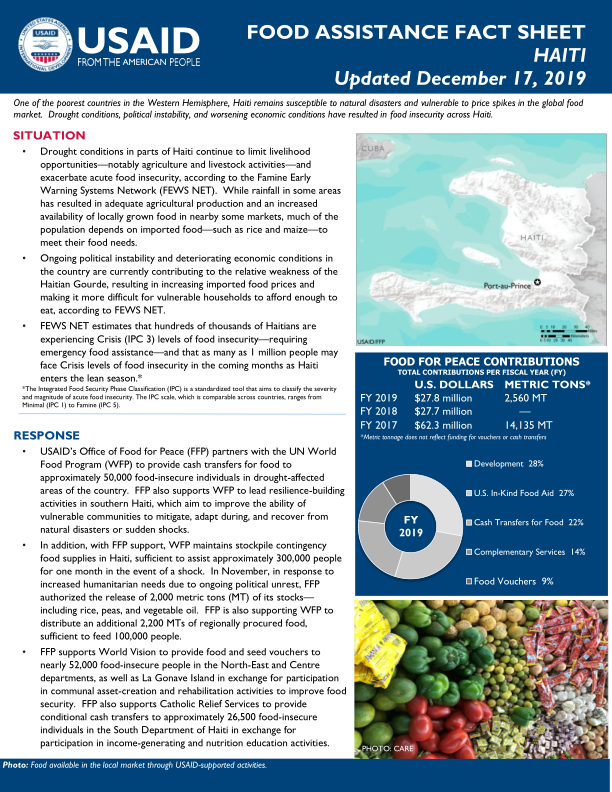One of the poorest countries in the Western Hemisphere, Haiti remains susceptible to natural disasters and vulnerable to price spikes in the global food market. Drought conditions, political instability, and worsening economic conditions have resulted in food insecurity across Haiti.
SITUATION
-
Drought conditions in parts of Haiti continue to limit livelihood opportunities—notably agriculture and livestock activities—and exacerbate acute food insecurity, according to the Famine Early Warning Systems Network (FEWS NET). While rainfall in some areas has resulted in adequate agricultural production and an increased availability of locally grown food in nearby some markets, much of the population depends on imported food—such as rice and maize—to meet their food needs.
-
Ongoing political instability and deteriorating economic conditions in the country are currently contributing to the relative weakness of the Haitian Gourde, resulting in increasing imported food prices and making it more difficult for vulnerable households to afford enough to eat, according to FEWS NET.
-
FEWS NET estimates that hundreds of thousands of Haitians are experiencing Crisis (IPC 3) levels of food insecurity—requiring emergency food assistance—and that as many as 1 million people may face Crisis levels of food insecurity in the coming months as Haiti enters the lean season.
RESPONSE
-
USAID’s Office of Food for Peace (FFP) partners with the UN World Food Program (WFP) to provide cash transfers for food to approximately 50,000 food-insecure individuals in drought-affected areas of the country. FFP also supports WFP to lead resilience-building activities in southern Haiti, which aim to improve the ability of vulnerable communities to mitigate, adapt during, and recover from natural disasters or sudden shocks.
-
In addition, with FFP support, WFP maintains stockpile contingency food supplies in Haiti, sufficient to assist approximately 300,000 people for one month in the event of a shock. In November, in response to increased humanitarian needs due to ongoing political unrest, FFP authorized the release of 2,000 metric tons (MT) of its stocks— including rice, peas, and vegetable oil. FFP is also supporting WFP to distribute an additional 2,200 MTs of regionally procured food, sufficient to feed 100,000 people.
-
FFP supports World Vision to provide food and seed vouchers to nearly 52,000 food-insecure people in the North-East and Centre departments, as well as La Gonave Island in exchange for participation in communal asset-creation and rehabilitation activities to improve food security. FFP also supports Catholic Relief Services to provide conditional cash transfers to approximately 26,500 food-insecure individuals in the South Department of Haiti in exchange for participation in income-generating and nutrition education activities.


